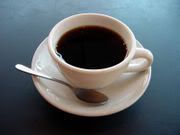 Coffee is a widely consumed beverage prepared from the roasted seeds—commonly referred to as beans—of the coffee plant. Though usually served hot it can also be served cold. A typical 7 fluid ounce (ca. 207 mL) cup of coffee contains 80–140 milligrams of caffeine, depending on the bean and method of roasting and preparation. Some people drink coffee "black" (plain), others sweeten their coffee or add milk, cream or non-dairy creamer. Coffee represents 71% of all the caffeine consumption in the United States, followed by soft drinks and tea. Coffee, along with tea and water, is one of the most popular beverages world-wide, its volume amounting to about a third of that of tap water in North America and Europe. In 2003, coffee was the world's sixth largest agricultural export in terms of value, behind wheat, maize, soybeans, palm oil and sugar.
Coffee is a widely consumed beverage prepared from the roasted seeds—commonly referred to as beans—of the coffee plant. Though usually served hot it can also be served cold. A typical 7 fluid ounce (ca. 207 mL) cup of coffee contains 80–140 milligrams of caffeine, depending on the bean and method of roasting and preparation. Some people drink coffee "black" (plain), others sweeten their coffee or add milk, cream or non-dairy creamer. Coffee represents 71% of all the caffeine consumption in the United States, followed by soft drinks and tea. Coffee, along with tea and water, is one of the most popular beverages world-wide, its volume amounting to about a third of that of tap water in North America and Europe. In 2003, coffee was the world's sixth largest agricultural export in terms of value, behind wheat, maize, soybeans, palm oil and sugar.ETYMOLOGY
The English word "coffee" is believed to be derived ultimately from the Arabic word qahhwa; it is called būnn or būnnā in Ethiopia in Amharic and būnnī in Tigrinya, and other variations on the original būnn in other languages. Coffee's Arabic name, qahwa is a truncation of qahwat al-būnn or wine of the bean. Traditional Islam prohibited the use of alcohol as a beverage, and coffee proved to be a suitable alternative.
The Arabic qahhwa was borrowed by Ottoman Turkish as kahve, which in turn was borrowed into Italian as caffè and French as café. Early forms date to as early as the last decade of the 16th century, but the word "coffee" itself did not come into use until the early to mid 1600s.
The Arabic qahhwa was borrowed by Ottoman Turkish as kahve, which in turn was borrowed into Italian as caffè and French as café. Early forms date to as early as the last decade of the 16th century, but the word "coffee" itself did not come into use until the early to mid 1600s.
HISTORY
 The history of coffee can be traced to at least as early as the 9th century, when it appeared in the highlands of Ethiopia and maghreb el Arabiy (which today consists of Algeria, Morocco and Tunisia). Whence it spread to Egypt and Yemen, and by the fifteenth century had reached Persia, Egypt, Turkey, and northern Africa.
The history of coffee can be traced to at least as early as the 9th century, when it appeared in the highlands of Ethiopia and maghreb el Arabiy (which today consists of Algeria, Morocco and Tunisia). Whence it spread to Egypt and Yemen, and by the fifteenth century had reached Persia, Egypt, Turkey, and northern Africa.From the Muslim world, coffee spread to Europe, and became popular there during the seventeenth century. The Dutch were the first to start large-scale importation of coffee into Europe, and eventually smuggled out some seedlings in 1690, as the Arabs were not allowed to export the plants or unroasted seeds. This led to coffee growing in Java, which was then a Dutch possession. In 1538, Leonhard Rauwolf, a German physician, having returned from a ten-year trip to the Near East, gave this description of coffee:
"A beverage as black as ink, useful against numerous illnesses, particularly those of the stomach. Its consumers take it in the morning, quite frankly, in a porcelain cup that is passed around and from which each one drinks a cupful. It is composed of water and the fruit from a bush called bunnu."
When coffee reached the American colonies, it was initially not as successful as it had been in Europe, as colonists found it a poor substitute for alcohol. However, during the Revolutionary War, the demand for coffee increased to such an extent that dealers had to hoard their scarce supplies of it and raise prices dramatically; part of this is due to the reduced availability of tea from British merchants. Americans' taste for coffee grew during the early nineteenth century, following the War of 1812, which had temporarily cut off access to tea imports, and high demand during the American Civil War as well as many advancements in brewing technology cemented the position of coffee as an everyday commodity in the United States. Today coffee is a staple of the North American breakfast and morning commute.
- wikipedia goblog -

No comments:
Post a Comment